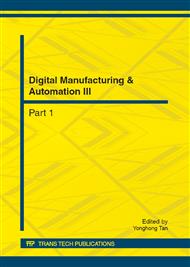p.547
p.551
p.555
p.560
p.567
p.571
p.575
p.581
p.585
Study on TiCN/Ti Based Composite Coating Fabricated by Reactive Electric Spark Deposition
Abstract:
In order to improve the wear-resisting properties of titanium alloy surface, reactive electric spark deposition was carried out using a graphite electrode in a nitrogen gas atmosphere, and TiCN/Ti based composite coating was fabricated on TC4 titanium alloy surface. The surface morphology, microstructure, interfacial behavior between the coatings and substrate, phase and element composition of the coatings were investigated by scanning electron microscope(SEM), X-ray diffraction (XRD) and Auger electron spectroscopy (AES). The microhardness hardness distributions as a function of depth were measured by a micro-hardness tester. The results show that the coating about 20μm thick is continuous, close, and completely covering the substrate surface and mainly composed of the TiCN phase which is in-situ synthesized by the reaction among titanium from the substrate, carbon from the graphite electrode and nitrogen from the shielding nitrogen gas. The coating has a strong metallurgical bonding and adhesion to the substrate. Microhardness profile falls off with the coatings thickness increasing and the highest microhardness values of the superficial coating could be up to 1496HV, which is six times more than that of the substrate.
Info:
Periodical:
Pages:
567-570
Citation:
Online since:
July 2012
Authors:
Price:
Сopyright:
© 2012 Trans Tech Publications Ltd. All Rights Reserved
Share:
Citation:


